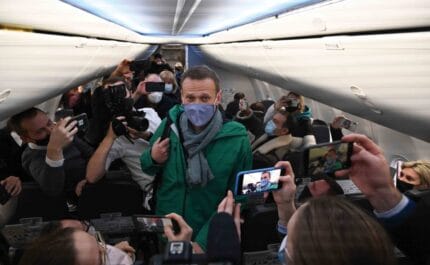Is farming rhinos the only way to save them?
Advocates for an end to the ban on the international trade in rhino horn argue that rearing the animals as livestock – which involves their horns being harmlessly removed and sold – would price poachers out of the game. As a critical deadline to legalise the practice loomed, we met the driving forces behind an industry which could bring its participants unimaginable wealth – or financial ruin
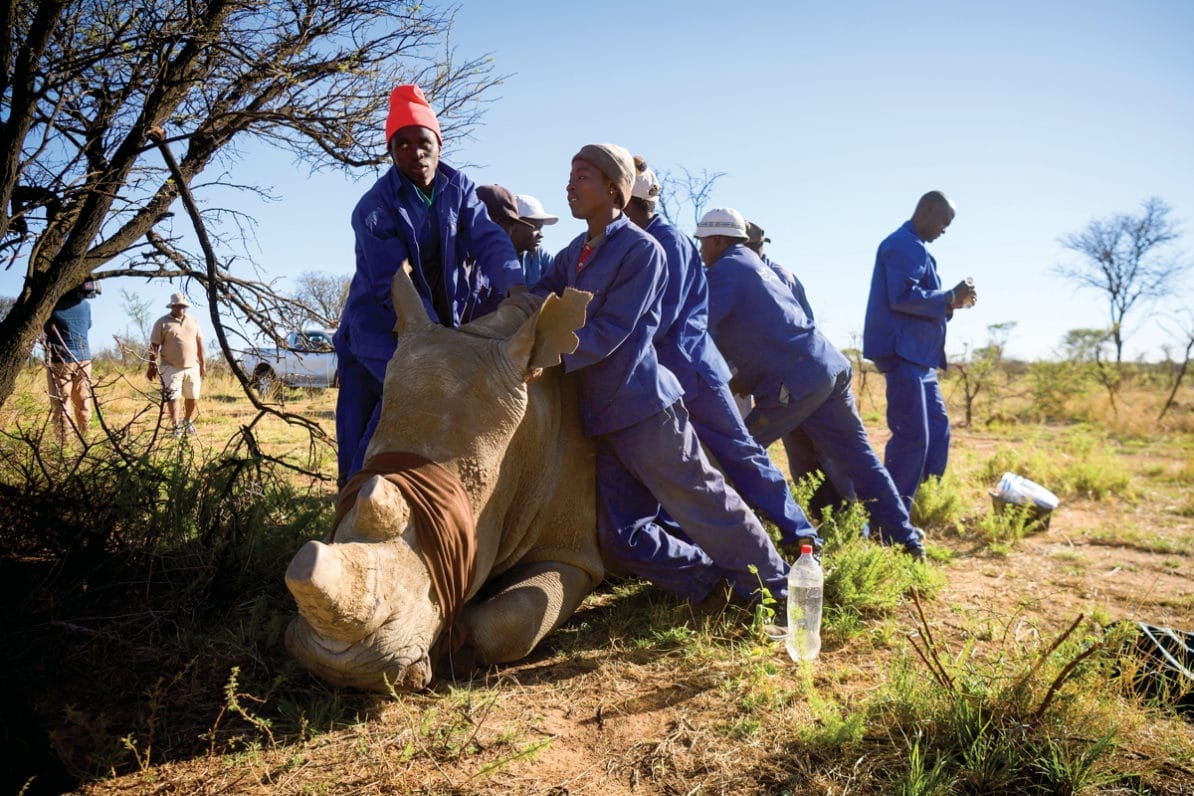
A white rhino is held in place to have its horn trimmed after being shot with a tranquilliser dart at the ranch of rhino breeder John Hume. Photo: Leon Neal / Getty Images
24th December 2018 (Taken from: #33)
Per gram, rhino horn is worth more than cocaine or gold. Six tonnes of it is enough to make you a millionaire, many times over. But John Hume, owner of the world’s largest rhino ranch and a six-tonne stash of harvested horn, is far from rich. In fact, he’s about to go bust.
Like much of his life, Hume’s offices are dominated by rhinos. Outside, on the front lawn, a bronze statue depicts a squat rhino mid-charge. Inside, on his study wall, a large metal rhino head is mounted next to an array of framed rhino photos and a rhino calendar. Below is a shelf of neatly arranged rhino ornaments.
As befits a man with such an unusual job, Hume is a larger-than-life character. He has a booming voice and a blunt yet charming manner. When he wants to hammer a point home – which is frequently – he has a habit of addressing you by your first name. Born in Southern Rhodesia, now Zimbabwe, Hume decided to emigrate in the early 1970s. It was a tumultuous time. A bloody guerrilla war that would ultimately overthrow white minority rule was erupting and Hume was looking for somewhere more stable to set up business. After stints in the US and Australia, he eventually settled on South Africa. There he established a string of successful leisure resorts and later wed his wife, Albina, a feisty Ukrainian woman who proposed after becoming bored with waiting for her suitor, 36 years her senior, to ask (an event she recounts with relish in her aptly titled autobiography Miss Fortune). All in all, Hume says, he had “been lucky and done well for himself”. And then he got into the rhino game.
It began in 1992. Wealthy, approaching his fifties, and with one eye already on retirement, Hume decided on one last business venture: a game ranch. It was, if all worked out as planned, to be a nest egg, a business that would generate revenue into his old age. After purchasing the land, he set about stocking his miniature ecosystem, buying “impalas, buffalos, flamingos, rhinos and the other usual things” (Albina’s book describes the ranch, rather more grandly, as like “being inside a National Geographic film”). Either way, it was life-defining for the couple. Hume was immediately enthralled by the “magnificent creatures” now living in his backyard, particularly one species. “Before that I’d never really met a rhino. I’d seen a couple in the distance before, but I’d never met one,” he tells me.
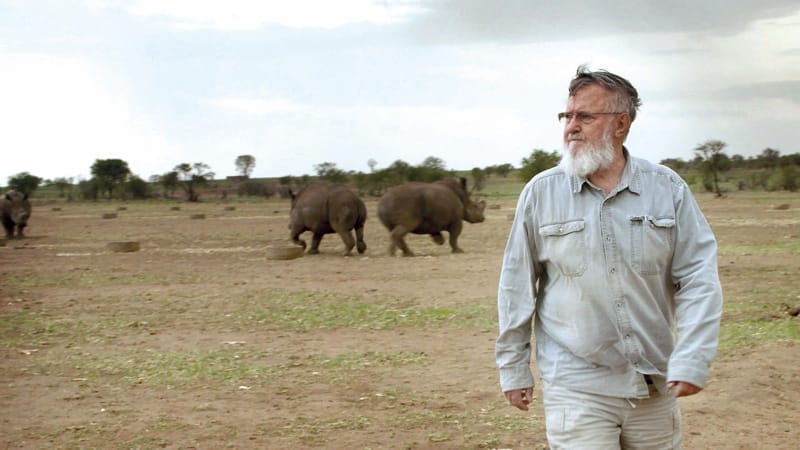
John Hume on his Buffalo Dream Ranch, the world’s largest rhino farm. Photo: Trophy / Park Circus
As he learned more about the plight of the rhinos, Hume began to wonder if there wasn’t “something he could do”. Ever the entrepreneur, it wasn’t long before he found an idea he thought could work, for him and the rhinos. While a buffalo and impala hunting ranch was profitable, the profits it fetched paled in comparison to the potential of rhino horn, which was fetching up to a staggering £100 per gram on the black market. Rhinos, he discovered, are relatively easy to breed. And, more importantly, horns could be safely and painlessly harvested from live animals – in fact, dehorning was becoming an increasingly routine practice in a bid to deter poachers. Why, he reasoned, let criminal gangs profit from slaughtering the creatures when the same money could be channelled into conservation by selling “bloodless horns” that didn’t involve killing a single rhino?
Game changer
Hume’s idea wasn’t so wacky in South Africa where, unlike the rest of the continent, private ownership of big game is commonplace thanks to the 1991 Game Theft Act, which essentially means landholders legally own wildlife on their lots. He could purchase more rhinos at auction from other owners and national parks looking to raise funds. And the business model was, on the surface, straightforward: make rhinos worth more alive than dead. Farm them, harvest their horns every two to three years (a painless procedure rather like cutting fingernails for a rhino, albeit under general anaesthetic), sell those horns, channel the money back into ranches and repeat. Simple – except for one big problem. The Convention for International Trade in Endangered Species (CITES) bans all international sales of rhino horn.
Hume’s idea wasn’t entirely new. Conservationists had long pondered whether Africa’s national parks should be able to sell off the valuable commodity taken from rhinos that had died of natural causes. But the general consensus was that there simply weren’t enough rhinos shuffling off the mortal coil of their own accord to meet demand in Asia, the end destination for most horn. Hume, however, was undeterred. It was, he reasoned, a problem of scale, one he thought farming could fix. If he generated enough horn, poachers would be priced out of the market. After all, he tells me, repeating a phrase that has become his mantra: “No animal that was successfully farmed ever went extinct. That just doesn’t happen.” It was this logic that made Hume plough ahead, despite the CITES ban.
Today, Hume’s herd has swollen to a staggering 1,650 rhinos, and with up to 300 cows pregnant at any one time, that number ticks up daily. It is, he says proudly as he talks me through a hand-drawn map of Buffalo Dream Ranch’s sprawling 8,000 hectares of paddocks and feeding stations that he’s tacked to his office wall, “the world’s most successful rhino breeding programme”.
Yet as Hume’s herd multiplied, his money dwindled. Instead of the CITES ban being lifted, things got worse. In 2009, the South African government announced a moratorium on internal trade in rhino horn. Previously, sales in the country had been legal and loosely regulated, a state of affairs that, in all likelihood, led to much of it slipping out of the country into the black market. Or as Hume puts it, for private rhino owners, “It wasn’t our business what buyers did with the horn, as long as we had sold it legally.”
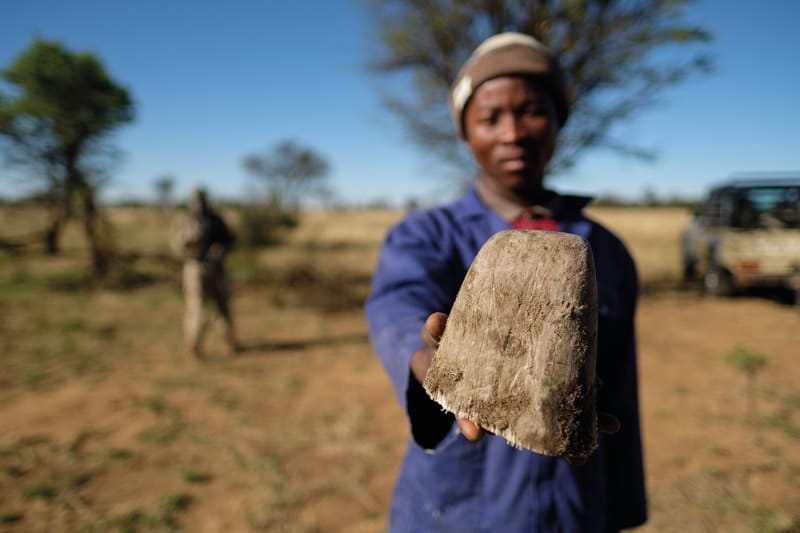
A ranch worker holds up the tip of a horn from a white rhino after it was removed during the trimming procedure.
Photo by Leon Neal / Getty Images
Hume and another rhino farmer, Johan Kruger, fought the moratorium tooth and nail in a lengthy and costly legal case. They ultimately won, six years later, on a technicality – the supreme court ruled that the government had failed to hold proper consultation proceedings. But the victory was bittersweet. The reinstated internal market was now tightly regulated. DNA certificates traced the horn all the way back to the seller and the bureaucratic red tape meant the paperwork for a single sales permit could take months to process.
Meanwhile, Hume had found himself fighting on another, even costlier, front. As demand for rhino horn in Asia surged in the mid-1990s, South Africa found itself at the epicentre of a poaching crisis. The country, home to around 80 percent of the world’s remaining 25,000 rhinos, had long been a beacon of hope for the species, but by the early 2000s it was losing three of the creatures a day to poachers’ guns.
With a third of South Africa’s rhinos in private hands, ranch owners like Hume were prime targets. “It was a war out there; you either fought or got out,” he says. Hume chose to fight, but at a cost. He installed a hi-tech new security system with smart motion sensors and heat-detection cameras. When these are triggered, an armed rapid-response unit is deployed to the exact site of the perimeter incursion. Poaching incidents have plummeted – Hume’s lost no rhinos in the last six months. But with a private anti-poaching helicopter on standby as well as a tracker-dog team, and a round-the-clock security detail, his overheads have soared to more than £300,000 per month.
By 2018, having sunk a cool £114 million into the rhino project since its inception, Hume was facing bankruptcy – what he calls “the countdown to day zero” in reference to the time remaining before his once-buoyant bank balance is exhausted. He was becoming increasingly desperate. In the months before I first visited Buffalo Dream Ranch, I spoke to Hume on the phone on several occasions. Our conversations were always frank and often surreal. In one, he announced he had sealed a “heart-breaking, but financially necessary” deal to sell his entire stock of rare black rhinos (16 in total) to the King of Swaziland. In another, he complained about the “disappointing” sales in an online auction of horn (the first ever held in South Africa) that had been translated into Vietnamese and Mandarin. When I asked whether he worried that Asian buyers might try to illegally smuggle their purchases out of South Africa he replied that he “didn’t give a damn” if they did because, in his opinion, it “wasn’t a sin”.
Hume fretted about frittering away all his money and having nothing left for his old age or to leave to his four children. He worried about what would become of his rhinos and bemoaned the “sheer idiocy” of these “animal-rights types” telling him what to do with them. The reality was, he admitted, that “I’m broke and if something doesn’t change, the whole project’s been an outright failure.”
When I visit Hume’s farm in November 2018 he is, by his own admission, “in a dither”. A pack of five Jack Russells yap energetically around his feet. “You’re just in time,” he announces. Albina is hurriedly gathering his coat and documents together and issuing instructions to a driver. Hume has been called to a last-minute meeting with South Africa’s new environment minister. It is, he hopes, a sign that he may still be granted an 11th-hour reprieve. A crucial deadline is looming.
In just under a month from our meeting, on 24th December, it will be the biennial deadline to submit proposals to CITES for a review of rules governing trade in protected species. Hume, who describes it as “last-chance” for his business, is hoping that South Africa will request that rhino horn is downgraded from its current ‘Appendix 1’ status to ‘Appendix 2’ – a change which, if passed, would unlock the estimated £93 million worth of horn that he has stashed away in secret locations across the country.
“The problem, Harriet,” Hume says with a sigh, “is I’m always backing the underdog, and now it’s got me in this mess.”
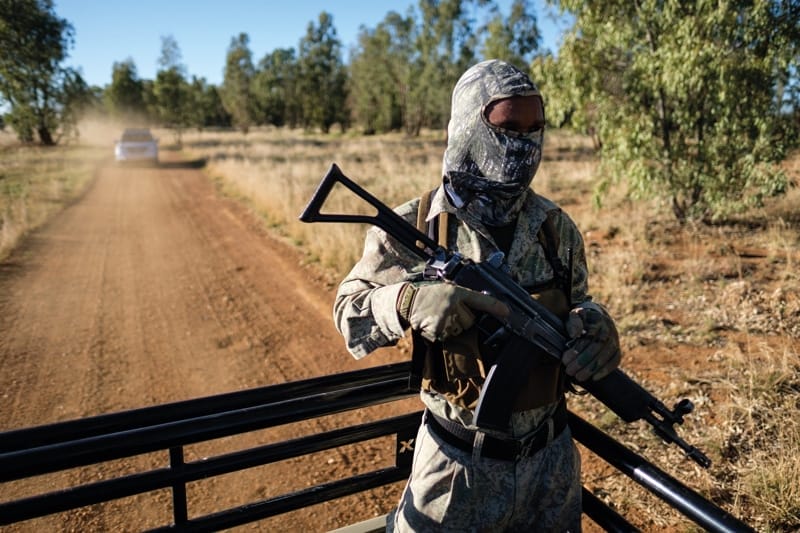
An armed guard rides in the back of a truck at John Hume’s rhino ranch, where overheads including hi-tech security run to £300,000 per month. Photo: Leon Neal / Getty Images
The numbers of the beast
At first glance, the fields of Buffalo Dream Ranch could be mistaken for a scene from Jurassic Park. It’s the tail end of the dry season in South Africa and I’m perched, somewhat precariously, on the back of an open trailer. Around me, as far as the eye can see, hundreds of prehistoric-looking creatures are converging on the flat grasslands around us. As we bump our way through the paddock, two farm hands heave a special nutritional mix of dry alfalfa and feed pellets down into a line of circular concrete troughs. The hungry rhinos nuzzle and nudge around the truck, squabbling for the best spot, impatient for lunch.
It wasn’t that long ago, however, that a sight like this might have been glimpsed in the wild – minus, of course, the troughs and tractor. As recently as the early 19th century, up to a million rhinos are thought to have roamed Africa’s grasslands. That era came to an end with colonialism, which brought to the continent an unsustainable penchant for gunning down big game.
In 1910, following a year-long safari expedition in the African bush, former US president Theodore Roosevelt described it as “the greatest of the great hunting grounds”. Roosevelt and his son Kermit notched up over 500 kills during the trip, including 13 rhinos. One, stuffed and sent back home, still boasts a spot in the mammal section of the Natural History Museum in Washington DC today.
But Roosevelt’s shooting prowess paled in comparison to that of other white hunters. Among the most notorious was Walter Dalrymple Maitland Bell, known as ‘Karamojo Bell’. A Scottish soldier and explorer, he shot more than 1,000 elephants, as well as hundreds of rhinos, lions and giraffes. But colonialists’ hunting guns weren’t the only threat to Africa’s wildlife. The spread of tsetse fly and the lethal sleeping virus it carries prompted calls from cattle farmers to cull bush wildlife – which they blamed, incorrectly, for spreading the illness that was killing their livestock. The allocation of large swathes of fertile land to white settlers also brought indigenous Africans into conflict with wildlife as they were pushed out of their territories and forced to abandon traditional lifestyles.
Never had I been so impressed and at the same time strangely involved with an animal”
Under the pressures of hunting, habitat encroachment and culling, the number of African rhinos nosedived from half a million to below 20,000 in just a few decades. The southern white rhino subspecies, which once roamed the savannahs of southern and eastern Africa, was particularly badly hit. It was briefly thought to be extinct until, in 1895, a group of around 50 survivors were discovered in a remote region of Zululand in South Africa.
Their descendants were saved by Dr Ian Player, who is lauded today as the godfather of rhino conservation. Back in 1952, the then 25-year-old occupied a less exalted position, having just been fired from an aluminium factory. His sacking probably saved an entire subspecies from extinction. When Player took up a new job as a ranger at Umfolozi Game Reserve in Zululand, the park that was set up to protect the small herd of white rhinos, he knew he had found his calling. In his 1972 book The White Rhino Saga, he recalls his first encounter with the creature: “Never had I been so impressed and at the same time strangely involved with an animal,” he wrote.
By then, the number of rhinos at Umfolozi had increased to 437 – Player counted them in an aerial survey in 1953. But, densely concentrated on a small range, they remained vulnerable to extinction. A single anthrax-infected cow, Player feared, could wipe out the entire herd. It was this worry that led him to launch “Operation Rhino” – a mission that would revolutionise conservation. Over the course of a decade he spearheaded the relocation of more than 1,100 rhinos from the park. The animals had to be tracked through the bush, darted with sedatives and loaded onto trucks. Rousing them at the other end was even more tricky. To administer the sedative’s antidote Player had to climb on top of the slumbering beasts to inject a vein their ears. The drug took effect quickly, and he was often “flicked off like a fly” before he managed to clamber down.
By the 1960s Player’s strategy was paying dividends. The southern white rhino had been reintroduced to ranges across South Africa as well as Zimbabwe, Kenya and Namibia. Player also scattered rhinos across the world by shipping them off to zoos and safari parks, a final safeguard against their extinction. In 1965 the subspecies became the first animal to be downgraded from ‘endangered’ to ‘threatened’ by the International Union for the Conservation of Nature. But a new threat was already looming.
The rhino wars
Bonné de Bod slid the bangles over her wrist and smiled awkwardly at the hidden camera strapped to her filmmaking partner, Susan Scott. She was, she later tells me, partly nervous at the risk she was about to take, but also desperate to hide her disgust. The jewellery on her arm was made from rhino horn and ivory. She had a part to play. ‘The product’, as it’s known to trade insiders, is a vital part of her disguise. De Bon was about to go undercover as a wealthy tourist looking to buy more of the illegal souvenirs in a small village in Vietnam.

A still from Stroop showing undercover footage of Bonné de Bod trying on rhino horn jewellery. Photo: Susan Scott, c/o Stroop
The footage that follows, shot at huge personal risk, is a remarkable and rare glimpse into what is driving the poaching crisis in South Africa. As de Bon and Scott make their way through the village bazaar, vendors hawk the illicit animal products in every form: from giant ivory carvings to bags packed with rhino horn shavings. It will, the sellers promise them, do everything from bringing wealth and prosperity to curing terminal illnesses.
It’s no wonder that de Bod, a television presenter known in South Africa for her reporting on wildlife, had to steel herself before donning the horn bracelets. She and Scott have spent the last six years investigating the country’s poaching crisis. The result, an independent documentary titled Stroop which was released in October 2018, recounts a litany of tragedy for both animals and humans: an emergency surgery to reconstruct a rhino’s face after its horn was gouged out; a poacher shot dead by park rangers while on bail for another poaching offence; the mews of orphaned calves found next to their mothers’ mutilated bodies. “It’s distressing and difficult to document,” says Scott. “But we went out there and did it, because this is the reality of what’s going on – people need to see it.”

Bonné de Bod goes undercover to speak with a Chinese doctor who promotes rhino horn treatments. Photo: Susan Scott, c/o Stroop
Africa’s ‘rhino wars’ – as the fight against poaching is known – can be divided into two equally bleak eras. The first began in the mid-1960s. Just as Player was resurrecting the southern white rhino, others were already being pushed to the brink of extinction. By the early 1990s the number of northern black rhinos had plummeted from 100,000 to just 2,400. The western black rhino fared even worse. By 1980, only 135 remained, located in just two countries, Chad and Cameroon. Meanwhile the number of northern white rhinos left in the wild sank from 2,000 to a paltry 15 by 1975.
The slaughter was the result of a perfect storm that started thousands of miles away. In Mao Zedong’s communist China, traditional Chinese medicine (TCM) was staging a comeback. Although several millennia old, TCM had been spurned as superstition by Chinese leaders after the collapse of the last imperial dynasty in 1911. Its revival some five decades later by Zedong, however, was not motivated by belief in its scientific value but by ruthless pragmatism. TCM was cheap and, more importantly, popular among the mass of rural peasants who supported his communist revolution. “Even though I believe we should promote Chinese medicine, I personally do not believe in it,” he admitted in private to one of his doctors. But while TCM was cost-effective for Zedong it would prove costly for Africa.
Among TCM practitioners’ most prized ingredients is rhino horn, believed to treat a host of maladies from fevers to blood diseases. Mired in a series of bloody wars as colonial authority collapsed and withdrew, Africa proved fertile ground for poaching networks to source the coveted commodity.
Africa’s plummeting number of rhinos eventually attracted international attention and the introduction of a total ban on the international trade in horn by CITES in 1977. The respite, however, was brief. By the early 2000s the second phase of the rhino wars was underway.
Horn had become so valuable that poachers even targeted a rhino orphanage, killing two infants”
Again, the roots of the crisis lay far from Africa. In Vietnam an acquisitive middle class was rising. The new money still had old tastes, however. Among them were ancient treatments that drew on TCM. Banned under CITES, rhino horn had become scarce and expensive. Its rarity, however, only stoked its mythical status. As well as the longstanding belief that it could reduce fevers, it was now also touted as, among other things, a miracle cure for cancer, a hangover remedy and an anti-aging ingredient in beauty products. Meanwhile, geopolitical shifts had also led to a resurgence in the rhino horn trade in Yemen – where it is used to make decorative dagger handles – as new smuggling routes via Saudi Arabia and the United Arab Emirates opened up in the 1990s.
This time around, the carnage centred on South Africa. It had been a relative safe haven during the first rhino war and as the epicentre of Player’s breeding and resettlement programme, it had seen its southern white rhino population increase while rhino populations elsewhere plummeted. By 2000, there were around 11,000 in the country – a remarkable comeback from Player’s early days as a ranger.
Meanwhile poaching rates were low, with an average of just 14 rhinos killed per year between 1990 and 2007. But what was initially a triumph for conservation took a dark turn. As demand for horn in Asia again surged, South Africa’s revitalised stock of rhinos was a boon for criminal networks looking to cash in on the high prices for horn. In 2008, in a sign of what was to come, the number of rhinos killed for their horn rocketed to 83. By 2015 the annual death toll had reached 1,215, around three rhinos poached per day – a growth of 1,364 percent in just seven years. Horn had become so valuable that poachers even targeted a rhino orphanage, killing two infants, and in another incident shot a recently dehorned rhino to prise a measly centimetre of regrowth from her face.
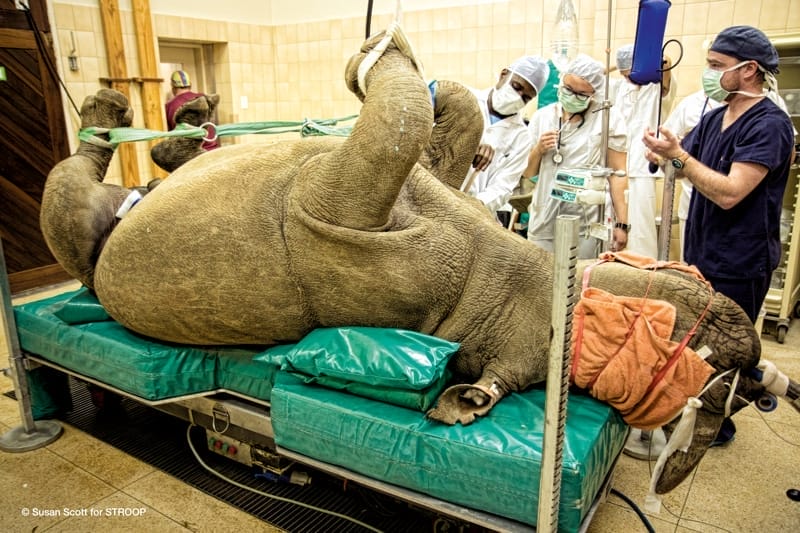
A rhino targeted by poachers is prepared for surgery at Onderstepoort Veterinary Hospital in South Africa. Photo: Susan Scott, c/o Stroop
Grey areas
On Christmas Eve 2018, just hours before the CITES submission deadline, I meet Cathy Dean at Save the Rhino’s London office. Everything here is rhino-themed, from the coffee mugs to the walls plastered with rhino news clippings. Dean, CEO of the charity, is sharp-witted and in exceptionally good shape. Propped up in the corner is a cumbersome-looking, full-body rhino suit, which she recently wore during the entirety of a 230km ultra-marathon in Kenya, one of eight long-distance fund-raising races she’s undertaken for rhinos over the years. Dean is among the most nuanced voices in the legalised-horn-trade debate. In anticipation of the CITES deadline she’s just completed a detailed and lengthy update on the issue for the charity’s website. Her position is clear. “Not yet,” she tells me.
While Save the Rhino is not inherently opposed to the sale of horn, Dean says there are just “too many what-ifs”. One of the concerns she highlights is that a legal trade in one country, such as South Africa, would create a cover for poaching networks operating in neighbouring countries like Zimbabwe. Another is a lack of understanding about how a legal market would impact on demand. As is the case for most shadowy and illicit trades, the data available on horn trade price fluctuations and destinations is scant and what exists is mostly small-scale, often obtained by modest teams of researchers going undercover at illegal markets or inside sources from criminal networks.
This dearth of reliable large-scale data, coupled with the many unknown factors, makes it difficult to accurately forecast the potential impact legal trade would have on poaching. For example, was – as the pro-trade lobby claim – the spike in poaching in the 2000s linked to South Africa’s internal prohibition on horn sale? Would – as anti-trade campaigners argue – a legal market in horn, with billboard posters and television adverts plugging products, create an insatiable demand that rhino farmers just couldn’t meet?
It’s really a feeling of euphoria, watching these horns burn. People were clapping and cheering”
“It’s frustrating, but without having all the data it’s impossible to know for sure. Yes, there are models, theories, predictions, but the only way to really to settle it is to see what happens if you have trade,” says Mike ’t Sas-Rolfes, a researcher on the horn and ivory trade economies at Oxford University. “Both sides’ arguments rest on a lot of implicit assumptions. Those that are pro-trade are assuming money will be reinvested on protection in an equitable way which will have a suppressing effect on poaching. Those that are against it are assuming a legal horn trade will drive up demand, or at least that the risk is too great to take.”
Ultimately, much of the trade debate comes down to little other than belief or “moral tribalism”. Imagine a pyre of burning rhino horn. What do you see? “The answer really depends on your perspective,” says t’ Sas-Rolfes. “If you see it as a valuable resource you’re going to think this is terrible: it’s going to drive up black market prices, more rhinos will die. If you’re against trade, you’re going to think it’s excellent: it’s sending out a strong message that we won’t tolerate this.”
Burning issues
The horn bonfire isn’t just a thought experiment. In 2017, Jan Stejskal, campaign coordinator of Burn Horns, Save Rhinos at Dvur Kralove Zoo in the Czech Republic watched as a pile of 25 horns weighing around 60kg was set ablaze. The burning event, the zoo’s second, took place under armed guard as horns they’d lent out to an educational exhibition that year had been targeted in a heist and never recovered. “It’s really a feeling of euphoria, watching these horns burn,” Stejskal tells me. “People were clapping and cheering.”
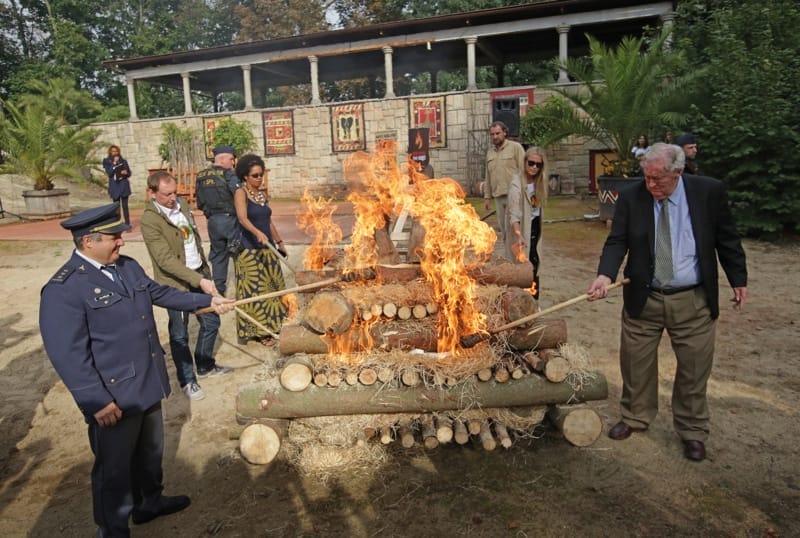
A pile of rhino horns is set on fire at the Dvur Kralove Zoo. Photo: Hynek Glos / Safari Park Dvůr Králové
The event’s guest of honour, charged with striking the match, was one of Stejskal’s personal heroes, Richard Leakey, a revered Kenyan conservationist and anthropologist. He pioneered the idea of publicly burning horn and ivory in 1989, when he destroyed 12 tonnes of seized product. The world’s largest such event to date, also held in Kenya in 2017, burned a haul worth an estimated £120 million. Stejskal, however, refuses to put a price-tag on the horns burned at Dvur Kralove Zoo. For him that would run counter to the point. “The message we want to give is that rhino horn has no value. It’s made from the same substance as fingernails and you don’t keep those, so there’s no reason to buy or sell horn for medical purposes or otherwise,” he tells me. Or as Leakey’s rather more direct statement on the Burn Horn website reads: “Intelligent, educated people worldwide recognise that horn from this critically endangered animal is worthless. Burning it and ridiculing those who value it is an excellent idea.”
It’s a debate where it’s hard to find a middle ground. As Stejskal points out, “You can’t tell people not to buy horn, and at the same time sell it. That’s just contradictory.” Emotions often run high and neither side is above slinging a barbed jibe across the trade war’s front line. “The problem,” says Pelham Jones, chair of South Africa’s Private Rhino Owners’ Association (PROA), is “these animal-rights can-rattlers” – his name for anti-trade NGOs, who he sees as at worst “self-interested” and at best “good but naïve”. Self-financing conservation in the form of a commercial horn trade would, he claims, call into question “their very existence”.
With neither NGOs or rhino farmers able to put forward a CITES proposal or vote on them – only signatory countries can do that – the trade war is rife with rumours, suspicion and accusations, as both sides battle for hearts and minds.
Dean says she has recently rebuffed an “advance” by an associate of Hume to open dialogue over Save the Rhino’s position on trade. She won’t tell me who they are, only that: “They didn’t address any of our concerns, they didn’t put anything new on the table, so I didn’t have anything to say to them.” Another high-profile anti-trade lobbyist, who didn’t want to be named, speculated that a recent trip to Hong Kong by Hume resulted in the Chinese government’s about-turn on a 25-year ban on the use of horn in TCM, which was announced on 29th October 2018, and later postponed after international outcry.
You can’t tell people not to buy horn, and at the same time sell it. That’s just contradictory”
“It certainly seems suspicious timing ahead of CITES so you have to wonder what’s happening behind the scenes,” they told me. Hume strenuously denied these allegations, calling them “a typical example of the nonsensical words coming from the anti-traders” and adding that: “If I had these sorts of capabilities, my rhinos wouldn’t be in the trouble they are now.”
On the other side, Jones blames the media for giving what he perceives as the upper hand to his opponents. Journalists, in his opinion, have given “much more of a platform to these animal-rights types than they should have” because it “sells papers”. During our interviews Hume also raises suspicions that I’m an anti-trade sympathiser looking to write a hate piece about him. Meanwhile, Dean is keen to point out to me that Save the Rhino is not about animal rights, as per Jones’s description, but rather conservation – the charity has controversially come out in favour of sustainable trophy hunting. Hume and Jones, she adds pointedly, both have plenty of “skin in the game” themselves. As she says, they are “businessmen who stand to become very rich from legal trade”.
Betting the ranch
For now, however, Hume’s money will remain where it is – locked up in horns deposited in vaults across the country. In early January 2019, the proposals submitted to CITES were released. South Africa had not put in a bid to downgrade rhino horn’s classification. When I phone Hume to check in after the proposals have been published, he says he’s “utterly devastated”.
The clock is ticking down towards day zero. According to Hume’s current timeline he is set to run out of funds as soon as April 2019. To stave off disaster he says he will, reluctantly, try to sell some of his precious rhino – which he sometimes refers to as “his darlings” – to stay afloat. However the security risks and costs attached to keeping the creatures makes it hard to find buyers – rhino horn retails at much higher prices than live rhinos.
Another potential source of income is ‘rhino coin’, a cryptocurrency set-up by pro-trade supporters of Hume. The blockchain-backed e-currency essentially invites investors to (virtually) join the rhino farmers by buying up their stock – each coin purchased by buyers is pegged to one “legally obtained, blood-free gram of horn”. For now, prices are low, around £2 per coin, due to the CITES regulations, but if international trade were to be legalised rhino-coin speculators and rhino farmers would stand to make a lot of money.
Hume has one last card up his sleeve. He’s recently submitted the paperwork to the South African authorities to try to establish his farm as a “captive breeding operation” (CBO), which would involve officially declaring himself a breeder-farmer trader rather than a wildlife trader. He needs to prove he’s bred a second generation on his property (essentially the grandchildren of truly wild rhinos) to be considered. It’s a loophole he hopes will enable able him to sell his horn overseas. If Buffalo Dream Ranch is declared a CBO, at least some of Hume’s herd would be considered farmed livestock, thus exempting from them CITES rules on trade in wild species. But while it’s a manoeuvre that has been successfully pulled off by African Grey Parrot breeders, Hume is the first to attempt it with rhinos and there’s no guarantee of success.
He’s also sending emails to the Forbes list of billionaires – there are 607 in the US and 2,153 worldwide, he tells me – trying to find a business partner to buy in to his ranch. “I only need one of those billionaires to take a chance and join me,” he says. But it will, he concedes, take a very particular sort of character. After all, he admits ruefully, “Investing in rhinos is a bit of gamble.”
Slow Journalism in your inbox, plus infographics, offers and more: sign up for the free DG newsletter. Sign me up
Thanks for signing up.

